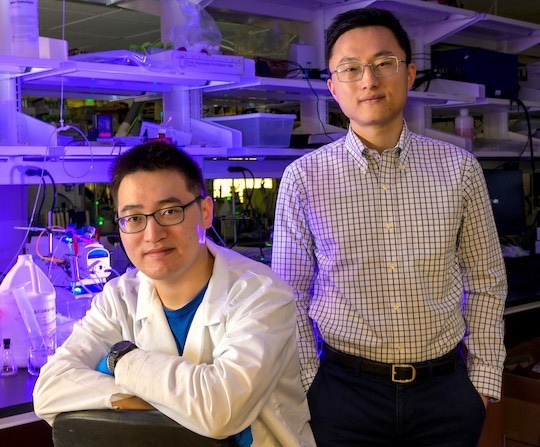Carbon dioxide (CO2) capture plays a crucial role in the sequestration process, which aims to prevent the release of waste CO2 into the atmosphere and mitigate the adverse effects of fossil fuel combustion on global warming.

Image Credit: Jeff Fitlow/Rice University
However, current technologies that utilize renewable energy for CO2 management, known as electrochemical carbon capture, face challenges such as low capture rates, sensitivity to oxygen, system complexity, and high costs.
To overcome these limitations and reduce the overall cost of carbon capture across various emission sources, a team of researchers and engineers at Rice University has developed an innovative technology.
Recently published in the journal Nature, this groundbreaking system has the potential to significantly impact the industry by helping the sector meet the climate goals for 2030 and 2050 while also setting new standards for the energy transition.
By attempting to bring carbon capture from the periphery, the system is anticipated to play a central role in electrochemical carbon capture, and in turn, in the fight against climate change.
Technology on a Sliding Scale
The technology developed by the team is a reactor that has the capacity to directly extract carbon dioxide from a number of different sources, ranging from atmospheric air to flue gas.
This reactor utilizes electricity to initiate an electrochemical reaction involving water and oxygen, enabling efficient absorption of CO2 molecules and achieving high carbon capture rates (>98%) in specific applications.1
Furthermore, the team at Rice University has tackled another significant drawback of current technologies. Most existing solutions rely on centralized, expansive infrastructure, restricting the accessibility and utilization of the technology to specific locations and users. However, the technology developed by the Rice team is versatile and can be employed in diverse carbon capture applications, accommodating different scales of implementation.
The technology can be scaled up to industrial settings ⎯ power plants, chemical plants ⎯ but the great thing about it is that it allows for small-scale use as well: I can even use it in my office.
Haotian Wang, Chemical and Biomolecular Engineer, Rice University
Another significant advantage of this technology is its chemical-free operation, eliminating the production of harmful substances. It also eliminates the need for pre-treatment steps like heating or pressurization, which are typically required in conventional practices and can reach extremely high temperatures of up to 900 degrees Celsius.1
The reactor developed by the team can be easily connected to a power source, and it carries out its electrochemical carbon capture function without any complicated setup.
Low Carbon Footprint
Moreover, this pioneering reactor technology has an extremely limited carbon footprint, especially when powered by electricity that is generated using renewable energy sources.
With renewables becoming more and more popular, this makes the technology even more promising in its application potential, as limiting energy consumption at the input makes capturing emissions from other sources more effective.
We could, for example, pull carbon dioxide from the atmosphere and continuously inject that concentrated gas into a greenhouse to stimulate plant growth. We’ve heard from space technology companies interested in using the device on space stations to remove the carbon dioxide astronauts exhale.
Haotian Wang, Chemical and Biomolecular Engineer, Rice University
The team’s reactor was constructed using a cathode assembly to facilitate oxygen reduction, an anode to perform the oxygen evolution reaction, and a compact yet porous solid-electrolyte layer to enable efficient ion conduction. While initially developed for reducing CO2 in liquid fuels and hydrogen peroxide solutions, the team observed a stream of bubbles emanating from the reactor during experiments.
Despite initially being regarded as an insignificant phenomenon, further investigation revealed a direct correlation between the current applied and the number of bubbles produced. This correlation indicated a non-random process, leading to a deeper understanding of the reactor’s behavior.
Drawing upon years of work, the team capitalized on these observations to refine the reactor design, resulting in an efficient electrochemical technology with tremendous potential to transform the future of carbon dioxide capture.
The electrochemical technology developed by the team at Rice University represents a significant advancement in carbon dioxide capture. By addressing the limitations of current technologies, offering versatility, chemical-free operation, and a low carbon footprint, this innovative reactor has the potential to play a pivotal role in mitigating climate change and achieving sustainable carbon reduction goals.
References and Further Reading
- Electrochemical device captures carbon dioxide at the flick of a switch (2023) Rice News | News and Media Relations | Rice University. Available at: https://news.rice.edu/news/2023/electrochemical-device-captures-carbon-dioxide-flick-switch
- Zhu, P. et al. (2023) ‘Continuous carbon capture in an electrochemical solid-electrolyte reactor’, Nature, 618(7967), pp. 959–966. Available at: https://www.nature.com/articles/s41586-023-06060-1.
Disclaimer: The views expressed here are those of the author expressed in their private capacity and do not necessarily represent the views of AZoM.com Limited T/A AZoNetwork the owner and operator of this website. This disclaimer forms part of the Terms and conditions of use of this website.